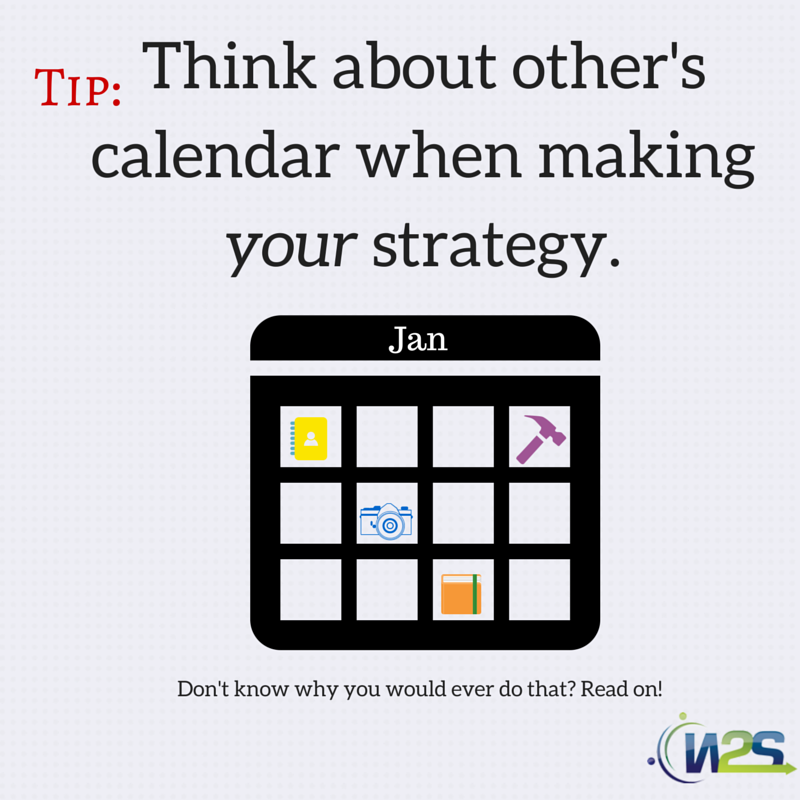Every New Year people call Mulligans, a do-over from last year.
(Highlight any sentence to click and tweet!)
Resolutions have become ineffective promises that leave you in the lurch when reality hits {Tweet this}. I’m pretty sure you have done this in your business too – we all have in fact. This is where strategy comes to the rescue. It is a framework for completion. A way to support your business before it becomes the “heat of the moment” and something doesn’t happen.
Creating your strategy doesn’t have to be difficult and you don’t have to create it from scratch. Here’s a *quick* list to use when putting together your marketing strategy and schedule. It’s not exhaustive, but will get you headed in the right direction. If you want more one on one help check out this option.
First, determine how much money do you want to make next year? This preliminary step allows you to create your revenue goals and ensure that your business activities are working to meet them.
How do you plan to accomplish these goals? A new offering? An increase in clients? A partnership? Break down these revenue goals to understand how to get them accomplished.
For example, if you wanted an increase of $25,000 in revenue. How many sales or programs is that? How many is that a month, a week, a day? Understanding, to this level, what it will take to reach your goals will actually make it easier to reach them!
Knowing these numbers will also give you a set of actions that are focused to create a result. It’s easy to fall into the trap of being “busy” without working however, having a goal and a plan significantly cuts that down.
This step ensures you meet your goals. It also lets you know if you are not on track. This step ties your actions to revenue to ensure you stay in business.
Now, you’re ready to sit down and start creating.
In this step you pick your dates. You are giving these money-making business activities an existence by putting them in your calendar. This now have a better chance of getting done. The first question is:
What days are you taking off?
Put these dates down on your calendar. Mark them out first so you don’t “accidentally” plan anything there.
Part of the great thing about being a business owner is that you can take time off to be with your family and friends. You make time for what’s important which is why this is the first thing you do when creating your marketing strategy.
To have this calendar work, you have to take into account your life and commitments. Don’t create something you cannot fulfill on. This is about creating a business you love and one that works.
“If it’s not broke, don’t break it.”
Next, you want to look at what events or programs worked last year.
- Are these events in alignment with your current goals?
- Do they serve a specific purpose?
- How will you ensure they meet those goals? (Follow up, limited time offer, discovery call)
These are great events or programs to add again. If it’s not broke, don’t break it. These events and programs can include things you’ve attended, programs you’ve created, or events and sales you’ve sponsored.
Next you want to add your marketing efforts that you always do, such as your newsletter, webinars, and other scheduled activities.
Finally, add your short term special events such as partnerships, speaking engagements, launches, or sales.
Remember this process doesn’t happen quickly. You often have to check your calendar, your children’s calendar, your SO’s calendar, and more. But that’s great! It means you are actually creating a business that works for your life.
Now we’re ready to create you editorial or content calendar.
This calendar is the basis for the type of content you will be creating and what business goal that content supports. Great content without purpose get’s you nothing. {Tweet this}
When you first outline your calendar look at themes you want your work to center around. What will you focus on each month? How will these themes support your business goals and objectives? This is where you create integration with your content and your activities. Isn’t it weird when a boutique has a sale and there is no mention of it on Facebook or Twitter. This won’t be you.
You can get theme ideas here:
- Q&A sessions
- Previous webinars
- Buying cycles of your ideal client
- http://www.brownielocks.com/month2.html
- Popular culture
By creating a theme that supports your business you don’t have to sit down and “think something up”. You already have a topic and a purpose when you sit down. Trust me, that makes writing so much easier.
Now set up your schedule. How often will you blog? Create a LinkedIn article? Create a video for YouTube? One you determine the frequency of these content pieces you will place these on the calendar along with your newsletter and webinars.
Now, you want to look at how social media can support this marketing calendar.
Do this by creating a process to share your content. This infographic gives a great example that you can adapt for your use.
However, I go more in depth in the next post.
Take a deep breath!
You have the quick and dirty way to create a strategy that will work for your business. Let me know in the comments what questions you have!
Or if you want to sign up for the webinar where you can ask all of your questions click here.
Until next time!

